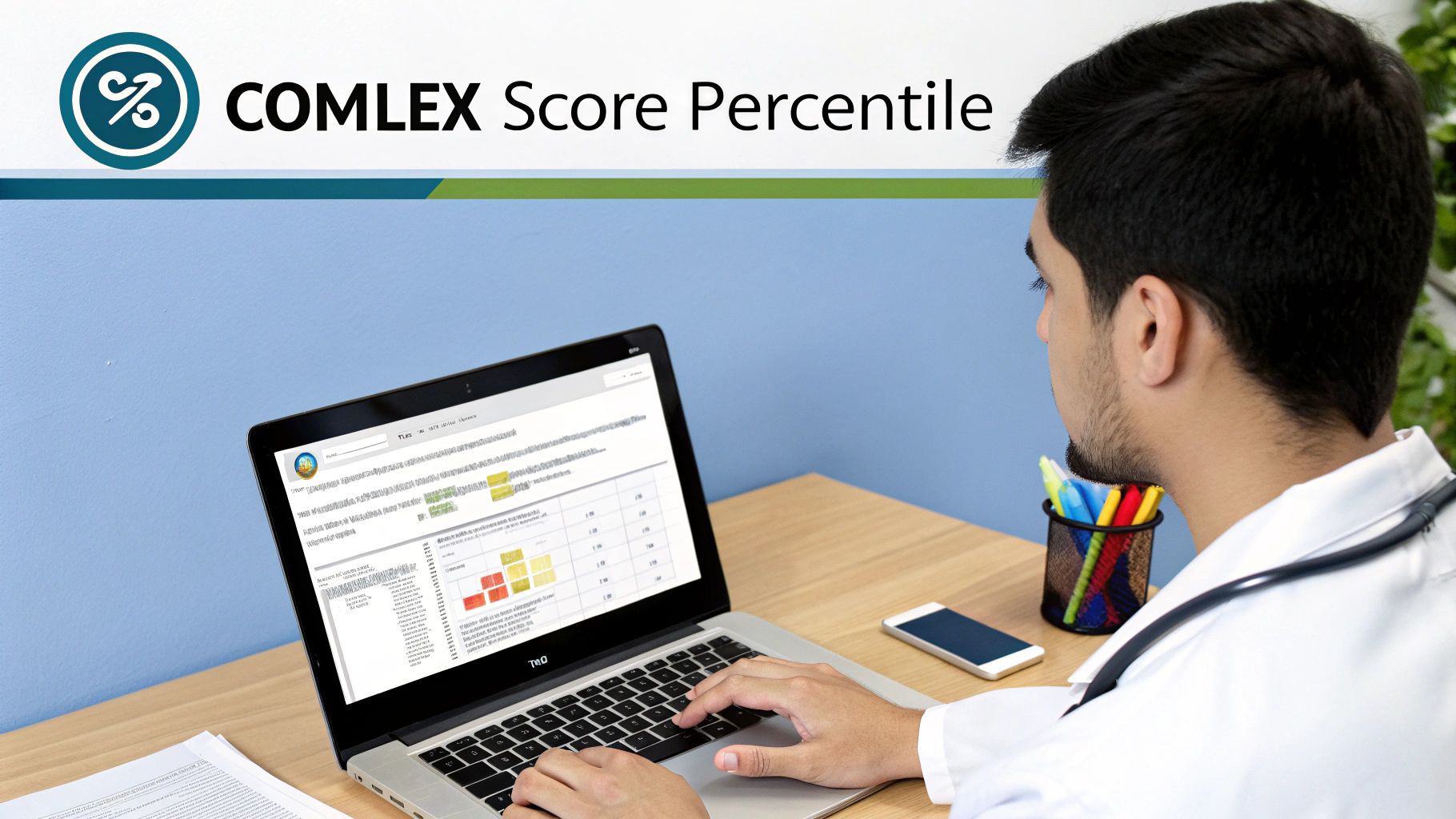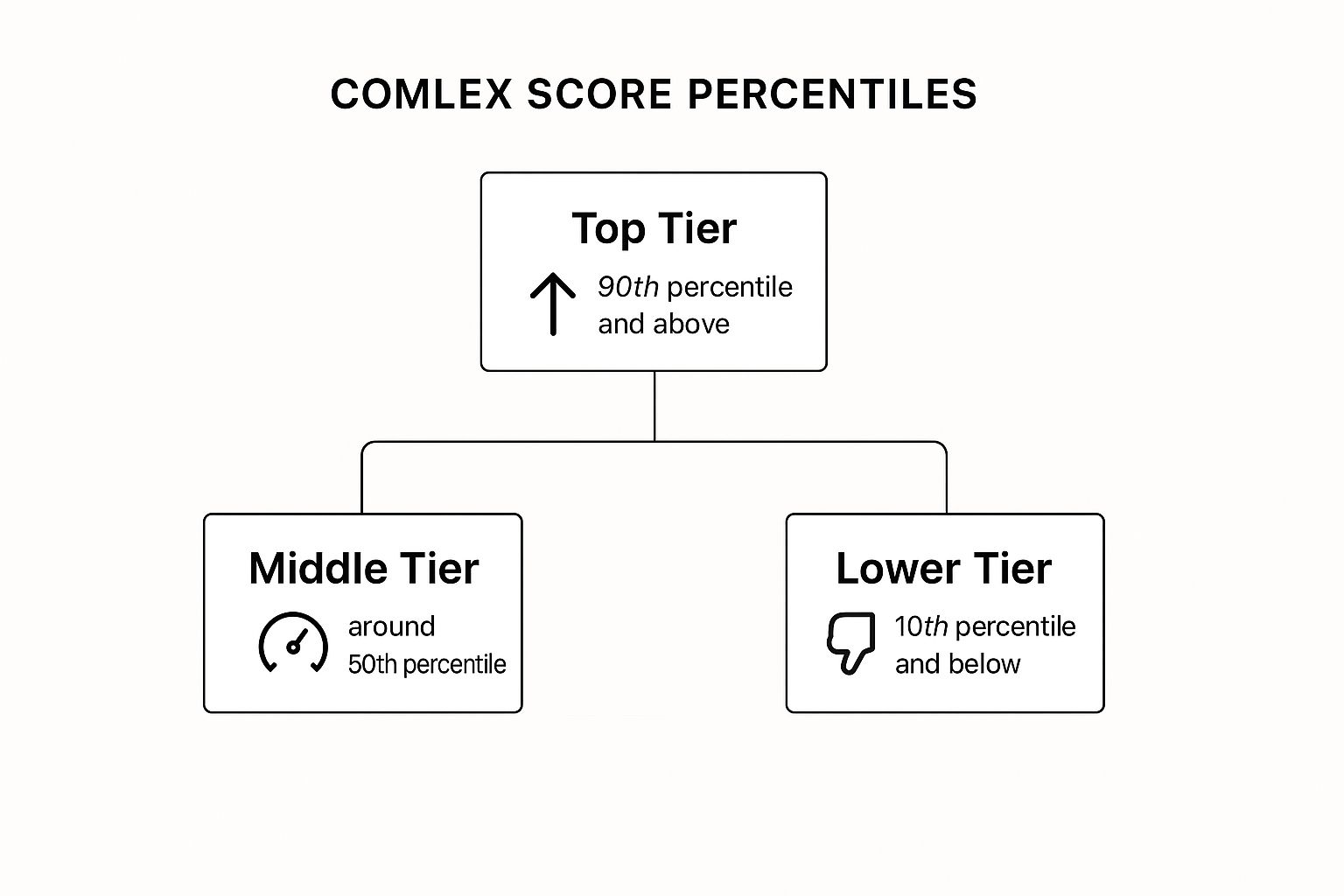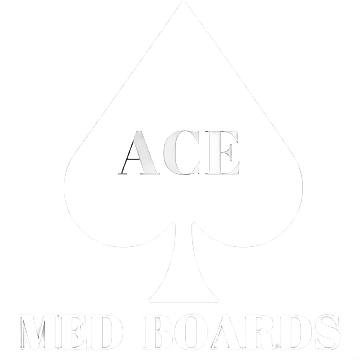A COMLEX score percentile isn't just a number—it tells you exactly how you measure up against every other osteopathic medical student in the country. It's less about your raw score and more about your competitive ranking.
For example, a 75th percentile score means you performed better than 75% of your peers. That simple percentage gives residency programs an immediate, clear snapshot of where you stand in the applicant pool.
What Does Your COMLEX Percentile Actually Mean?

While your three-digit COMLEX score is the official result, the percentile is what provides the crucial context. It’s the number that answers the big question on every program director’s mind: "How well did this applicant perform relative to everyone else?" This comparison is what makes or breaks your competitiveness.
Think of it like a race. If one runner finishes in 55 minutes and another in 58 minutes, you don't know if those are impressive times without more information. But if you learn the 55-minute runner placed in the 90th percentile and the 58-minute runner was in the 50th, you instantly get the full picture. Your COMLEX percentile functions in the exact same way.
Score vs. Percentile: What's the Difference?
To really make sense of your score report, you have to get comfortable with the distinction between your score and your percentile rank. They each tell a different piece of your performance story. Getting this right is the first step to using your score strategically when you apply for residency.
Here's a quick breakdown to clear things up:
| Metric | What It Represents | Why It Matters |
|---|---|---|
| Raw Score | The total number of questions you answered correctly. | This is just the initial calculation. It's not reported to you or to residency programs. |
| Scaled Score | Your raw score converted to the standardized, three-digit number you see on your report. | This is your official score, but it doesn't show how you compare to others on its own. |
| Percentile Rank | The percentage of test-takers whose scores were lower than yours. | This is the key metric for competitiveness. It’s what shows residency programs where you stand nationally. |
The relationship between scores and percentiles is also a major focus for researchers, especially for students who take both the COMLEX and USMLE. There are ongoing studies that use statistical methods to map equivalent percentile ranks between the two exams. This work helps program directors better interpret an applicant’s performance, no matter which test they took.
This research ensures your COMLEX percentile is understood in the broader context of all medical school graduates. For a deeper dive, you can explore the findings of one such study on percentile concordance.
How to Read Your COMLEX Score Report

Opening your official score report from the NBOME can be an intense moment. The screen is filled with numbers, charts, and data, but knowing where to focus makes all the difference. The first thing you’ll probably notice is your name, your ID, and that big, bold, three-digit number—your scaled score.
While that score is important, the next thing you should find is your COMLEX score percentile. This is usually right next to your scaled score, often in a table or alongside a graph. This single number is what gives your score its real-world context by showing you exactly how you stacked up against every other student who took the exam nationally.
Seeing a score of 650 is one thing. But seeing that a 650 also puts you in the 75th percentile? That’s a game-changer. It immediately tells you (and residency programs) that you performed better than three-quarters of your peers.
Breaking Down Your Performance Profile
Beyond the headline numbers, your report contains a graphic breakdown of your performance. This is your personal roadmap for identifying exactly where you shined and where you have room to grow.
The chart usually breaks down your performance into two main categories:
- Competency Domains: This is where you see how you did on foundational skills, like Osteopathic Principles, Practice, and Manipulative Medicine; Osteopathic Patient Care; and Application of Knowledge for Osteopathic Medical Practice.
- Clinical Disciplines: This section gives you the rundown on your performance in core subjects like Emergency Medicine, Family Medicine, Internal Medicine, and Surgery.
Think of each bar on the graph as a measure of your strength in that area compared to a candidate who just barely passed. The longer the bar, the stronger your performance.
Your score report is more than just a grade; it's a diagnostic tool. Use the performance profile to see exactly where you excelled and which topics might need more attention for future exams or clinical rotations.
By looking past that single three-digit number and digging into these details, you can turn your score report from a source of anxiety into a practical guide for the rest of your medical education. This deeper understanding is absolutely vital for building a strong, strategic residency application.
Why Your Percentile Matters More Than Ever
The game has changed. With the USMLE Step 1 exam now pass/fail, the entire residency application landscape has been thrown for a loop. Program directors, who once relied on that three-digit score to quickly sort through thousands of files, are now looking for other objective data points. And for osteopathic students, that puts a massive spotlight right on your COMLEX score percentile.
Let's be blunt: your COMLEX Level 2-CE performance is no longer just another box to check. It’s now one of the most powerful tools you have to differentiate yourself. Program directors need a way to gauge your clinical knowledge against a national standard, and a strong percentile tells them exactly where you stand. It’s become a critical first impression.
The New Landscape of Applicant Evaluation
In this post-Step 1 scoring era, your percentile rank has essentially become a sorting hat. Where a numeric Step 1 score used to be the first hurdle, program directors are now leaning heavily on other quantitative metrics to build their initial interview lists. A high COMLEX percentile is what gets your foot in the door and ensures your application gets a serious look, especially for competitive specialties.
This isn't just a COMLEX-specific phenomenon. We're seeing the exact same trend in the allopathic world, where Step 2 CK scores have become king. In fact, recent data shows that roughly 40% of residency applicants saw their rank drop after the Step 1 change, showing just how much weight has shifted to second-level board exams. Understanding this is key—a stellar COMLEX Level 2-CE percentile can put you on equal footing with an applicant who has a top-tier Step 2 CK score. You can read more about how Step 2 scores now shape residency selection to see the parallels.
A strong COMLEX percentile is your chance to shout from the rooftops that you're ready. It proves you have the knowledge base to hit the ground running and gives program directors a very compelling reason to offer you an interview.
At the end of the day, your percentile isn't just a number. It’s the story of how you measure up against every other osteopathic medical student in the country. A percentile in the 80th range or higher, for instance, immediately signals that you’re in the top echelon of applicants. That kind of distinction can open doors to highly competitive programs and specialties. It’s your ticket to being seen.
Using Your Percentile to Target Residencies
So, you have your COMLEX percentile. What now? That number isn’t just a grade to feel good or bad about—it’s one of the most powerful strategic tools you have. Think of it as a GPS for your residency applications. It helps you build a smart, targeted list of programs, making sure you apply where you’re a strong candidate while still reaching for those ambitious goals.
A high percentile gives you a green light for the most competitive specialties. On the other hand, a solid, average percentile makes you a fantastic applicant for many excellent primary care programs and other valuable fields. Getting this right is the key to building a balanced application list that truly maximizes your chances of matching. You can avoid the stress of applying too broadly or, even worse, too narrowly.
This image breaks down the general tiers of competitiveness you can expect based on different percentile ranges.

As you can see, performance generally falls into a few key tiers. Each one lines up with different levels of specialty competitiveness. It’s a simple way to map your national standing to a practical, real-world application strategy.
Mapping Percentiles to Specialty Competitiveness
How do you translate your percentile into an actual application list? The trick is to align your COMLEX score percentile with the data on applicants who have successfully matched in different specialties.
Here’s a general breakdown:
- Top Tier (80th-99th percentile): Scoring in this range is an exceptional performance. You are likely a very competitive candidate for the most sought-after specialties, like orthopedic surgery, dermatology, or integrated interventional radiology.
- Strong Tier (50th-79th percentile): This is a great place to be. Your score makes you a strong candidate for many competitive programs, including anesthesiology, emergency medicine, and general surgery. It also positions you extremely well for top-tier primary care residencies.
- Competitive Tier (Below 50th percentile): While you’ll need to be more strategic with your list, you are still a competitive applicant for many fantastic programs. This is especially true in essential fields like family medicine, pediatrics, and psychiatry.
The table below provides a general guide for how different COMLEX percentile ranges tend to align with the competitiveness of various medical specialties. It's a great starting point for building your initial list.
COMLEX Percentile Ranges and Specialty Competitiveness
| Percentile Range | General Competitiveness Level | Example Specialties |
|---|---|---|
| 80th – 99th | Highly Competitive | Orthopedic Surgery, Dermatology, Otolaryngology (ENT) |
| 60th – 79th | Very Competitive | Anesthesiology, Emergency Medicine, General Surgery |
| 40th – 59th | Competitive | Internal Medicine, OB/GYN, Pathology |
| Below 40th | Less Competitive | Family Medicine, Pediatrics, Psychiatry, Physical Medicine |
Remember, this table is a general framework. Your overall application—including letters of recommendation, research, and clinical grades—plays a huge role. Use your percentile as one key piece of the puzzle, not the whole picture.
Key Takeaway: Your percentile helps ground your application strategy in reality. Use it to anchor your list with programs where you are a strong fit, then add a few "reach" and a few "safer" programs to create a well-rounded and balanced approach.
Once you’ve used your percentile to identify target residencies, the real work begins. Crafting a standout application is crucial. This means having a polished CV, and using a professional CV builder can help you organize your experiences and achievements effectively. Of course, a strong score starts with a strong plan; creating a detailed COMLEX Level 1 study schedule is what builds the foundation for achieving the score you need in the first place.
Common Myths About Your COMLEX Percentile

The residency application process is filled with stress, and a lot of that anxiety comes from bad information. When it comes to your COMLEX score percentile, a few persistent myths can cause unnecessary panic. It's time to clear the air and separate fact from fiction.
One of the biggest fears for medical students is that a single number will define their entire future. Let's do a reality check on how residency programs actually review candidates.
Myth 1: A Low Percentile Means I Won't Match
This is easily the most destructive myth out there. A lower-than-expected percentile is not a death sentence for your residency dreams—not even close. While a high percentile certainly helps, especially for the most competitive specialties, program directors are looking for well-rounded future physicians, not just good test-takers.
The truth is, residency programs conduct holistic reviews. They understand that a single exam, taken on one specific day, is not the full measure of a candidate's potential.
Reality Check: Your application is a portfolio, not a single data point. Strengths in other areas—like stellar clinical grades, compelling letters of recommendation, meaningful research, or a powerful personal statement—can absolutely compensate for a less-than-ideal percentile.
Focus on building a strong overall profile. A lower score might mean you need to be more strategic with your application list, but it rarely closes the door entirely.
Myth 2: Only My COMLEX Score Matters
This myth is the flip side of the first one. Some students who score in a high percentile believe their number is a golden ticket, allowing them to coast on other parts of their application. This is a critical mistake.
Program directors read every part of your file. They are building a cohesive team and want to see solid evidence of professionalism, teamwork, and clinical acumen—qualities a test score simply cannot demonstrate.
Here’s what else they’re looking at:
- Letters of Recommendation: What do attending physicians really say about your clinical skills and work ethic?
- Clinical Grades: How did you actually perform during your core rotations?
- Personal Statement: Who are you as a person, and what truly drives you to pursue this specialty?
- Research and Activities: What have you done to show your commitment and passion beyond the classroom?
If you're struggling to balance test prep with these other critical areas, personalized guidance can make all the difference. Exploring options like professional COMLEX tutoring can help you develop an efficient study plan, freeing up precious time to strengthen your complete application.
Answering Your Top COMLEX Score Questions
Once you get that COMLEX score report, your mind probably starts racing with questions. It's totally normal. Beyond the numbers and charts, you need to know what it all really means for your future.
Let's cut through the noise and get straight to the practical answers you're looking for. From figuring out what a "good" percentile is to deciding on a retake, this is the information you need to move forward with confidence.
What Is a Good COMLEX Score Percentile?
This is the million-dollar question, and honestly, the answer is: it depends entirely on your residency goals. A "good" score is completely subjective.
For the most competitive specialties like dermatology or orthopedic surgery, programs are often looking for applicants scoring in the 80th percentile or higher.
But for many fantastic programs in fields like internal medicine, pediatrics, or family medicine, a score right around the 50th percentile is often considered strong and competitive. The trick is to research the average scores for your target specialty. A "good" score is simply one that makes you a competitive candidate for the programs you care about most.
Do Residency Programs See My Percentile?
Yes, they absolutely do. When your COMLEX-USA transcript zips over to programs through ERAS, they get the full picture. This includes your three-digit score and your COMLEX score percentile rank.
Program directors love percentiles because they provide instant context. A score of 600 might not mean much by itself, but seeing it’s in the 65th percentile immediately tells them how you stack up against your peers nationwide. It's often one of the first data points they use to sort through a mountain of applications.
Should I Retake the COMLEX for a Higher Score?
Hitting the "retake" button on the COMLEX is a huge decision and shouldn't be taken lightly. If you passed, the only time to seriously consider it is if your score is a major roadblock for your target specialty and you are genuinely confident you can make a significant jump.
Keep in mind that all of your attempts are visible to program directors. A small bump in your score might not be worth the risk, time, and financial cost. It's often a better strategy to pour that energy into strengthening other parts of your application, like getting stellar letters of recommendation or crushing your clinical rotations.
The pressure of prepping for a retake can be absolutely draining, too. You have to actively manage the mental and emotional toll, because that kind of prolonged stress is a fast track to burnout. Recognizing the signs of academic fatigue is key, and our guide on preventing USMLE and COMLEX exam burnout offers real strategies to help you stay resilient.
Ultimately, this is a conversation to have with your academic advisor or a mentor you trust. They can help you realistically weigh the potential pros against the very real cons.
At Ace Med Boards, we get it. Navigating COMLEX scores and the whole residency application maze is tough. Our expert tutors provide personalized guidance to help you not only hit your target score but also build a competitive application that truly showcases your strengths. Visit us at https://acemedboards.com to book a free consultation and take the next step toward your medical career.

